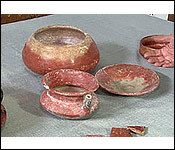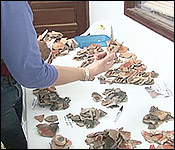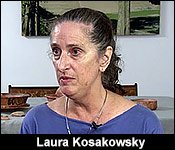
 She's been studying Maya ceramics for four decades and in that time Dr Laura Kosakowsky has learned that the Maya could have set their famous calendar by the ceramics their civilization produced. Cherisse Halsall travelled to Belmopan today for a first-hand look at the ancient pots of the Maya.
She's been studying Maya ceramics for four decades and in that time Dr Laura Kosakowsky has learned that the Maya could have set their famous calendar by the ceramics their civilization produced. Cherisse Halsall travelled to Belmopan today for a first-hand look at the ancient pots of the Maya.
Laura Kosakowsky, Ceramicist
 "This is an example of the earliest Maya pottery we find in Belize. It dates to somewhere probably between 1000 and maybe 600 B.C. and you can see it's a fairly simple bowl but It is also well made and well preserved in this case, it's been in the ground since 2000 years before it was found. And as we move through time this is late pre-classic pottery so this dates to between 300 B.C. and more or less 250 A.D. and again you've got bowls and dishes that would have been used for serving, for cooking, for processing food. This vessel with a spout is what we call a chocolate pot because we think it was used to froth cacao to drink. And these are examples of sherds from the same period because broken pieces of pottery is really what archaeologists usually find."
"This is an example of the earliest Maya pottery we find in Belize. It dates to somewhere probably between 1000 and maybe 600 B.C. and you can see it's a fairly simple bowl but It is also well made and well preserved in this case, it's been in the ground since 2000 years before it was found. And as we move through time this is late pre-classic pottery so this dates to between 300 B.C. and more or less 250 A.D. and again you've got bowls and dishes that would have been used for serving, for cooking, for processing food. This vessel with a spout is what we call a chocolate pot because we think it was used to froth cacao to drink. And these are examples of sherds from the same period because broken pieces of pottery is really what archaeologists usually find."
Anthropology is the scientific study of humans, human behaviour and societies. And when studying stone age civilizations like the Maya, difficulties arise from the simple truth that those societies are gone, the people that once inhabited them are bones and dust.
How then can we approach any knowledge of their day to day lives? I sat down with Anthropologist and Ceramicist Dr. Laura Kosakowsky who believes that ceramics tell a very complete story of ancient Belize.
Laura Kosakowsky, Ceramicist
"You can look at socio-economics you can look at politics, you can look at the trade you can figure out where things were traded from because of styles or doing more advanced chemical composition analysis."
"The reason we study Maya ceramics, prehistoric Maya ceramics, is because they are very durable so they preserve very well in the archaeological record and that means they are the most common item that we find on a Maya archaeological site so they are easily studied because they preserve well. Secondly, Maya ceramics are one of our main sources of chronology that's how we cross date archaeological sites in the Maya lowlands."
But of course, what is most interesting is the politics of the period. What can ceramics teach us about the wars fought, journeys taken, alliances made, and the births and deaths of Kings?
Laura Kosakowsky, Ceramicist
"Particularly when you have decorated pottery with glyphs on them the first thing you can do is the glyphs may indicate where the pot was made and therefore the pot then ends up somewhere else either as a gift from a queen or a king to an elite at another site."
The other way is through chemical compositional analysis which requires taking a very small piece from a pot. 04:15
Laura Kosakowsky, Ceramicist
"That then can be analyzed and you can look at the clays that they're made from and clays are different regionally across Belize as well as across the Peten and across the Maya lowlands so you can look at the compositional analysis of the pot and sometimes, not always, figure out where it might have come from. So again that tells you something about the traditional trading relationships in ancient times between various sites."
Dr Kosakowsky's work has focused on the larger portion of Mayan society, not the priest or the king, but the common person, and it is through the ceramics found in the remains of households that she has developed an interesting theory about one aspect of the division of labour in Maya society.
Laura Kosakowsky, Ceramicist
"The important part of Maya ceramics is that they're found in households, they're found in the refuse from households and they also are found in very specialized elite contexts as well like burials and caches as well as the burials and caches of everyday people so we can look at pottery and understand what they are used for cooking and for storage or for serving their food."
"Most households or household groups were potters so, in other words, they were making their own pottery for everyday use. It does not seem as if specific household groups are simply getting their pots from someone else. It would appear that they made their own pottery. Now what's a little bit odd is we're actually not entirely sure where they made pottery. We have not really found pottery kilns in the Maya lowlands, there are a few examples but not very many. So we don't know where the exactly made or fired their pots this has been a mystery. We don't know if potters were males or females, or both."
And Dr. Kosakowsky has studied ceramics all over Belize. She can even classify them by region based on the clay from which they were made.



